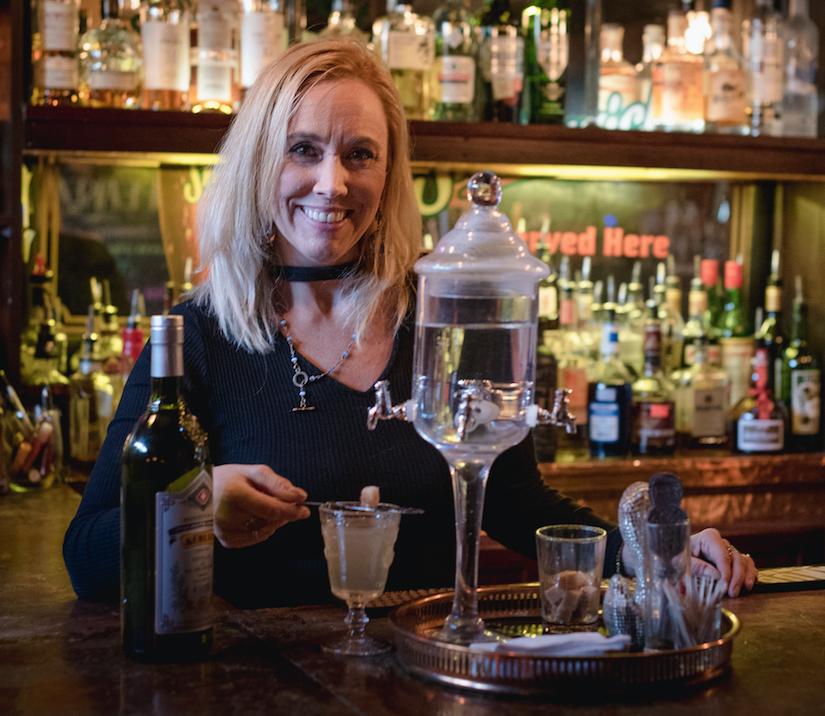You’re not hallucinating: Craft cocktails using absinthe are increasingly showing up in Asheville bars. Ever since a de facto ban on the spirit went away in 2007, enterprising and adventurous bartenders have been finding creative ways to add the legendarily maligned and misunderstood drink to their offerings.
Before we dip into absinthe, let’s dispel a few strongly held beliefs about it. “The No. 1 misconception is that it will make you completely trip out, like you took a bunch of hits of acid,” says Jax Hammond of The Conundrum. “People ask me all the time, ‘Am I going to see a green fairy?’” says Amanda Phillips of Sovereign Remedies. “No. No, you’re not.”
The ingredient that gives absinthe its allegedly psychedelic properties is thujone, a chemical compound present in wormwood, one of the botanicals used to make the drink. But the truth is that the quantity of thujone in the distilled spirit is far too low to do much in the way of mind-altering. As Amy Stewart explains in her best-selling 2013 book, The Drunken Botanist, the common herb sage contains more thujone than is found in wormwood. “To hallucinate, you’d probably have to drink a whole bottle of absinthe,” Hammond says with a wink.
Drinking a whole bottle of absinthe wouldn’t be a good idea; many commercially available brands are much stronger than, say, vodka.
There was an absinthe ban for many years in other countries, most notably France (where it was, for a time, more popular than wine) and Switzerland, its country of origin. As a result, many people mistakenly believe absinthe is illegal for sale in the United States. Published in 1953, David Embury’s influential The Fine Art of Mixing Drinks perpetuated this thinking. But it’s simply not true; while it has long been regulated, the spirit is now easily found in most liquor stores and many bars.
Absinthe developed its notorious reputation in part thanks to a familiar culprit: competition. In France, winemakers helped paint a picture of absinthe drinkers as dissolute and even violent. The drink was favored by many artists and creative types at the turn of the last century, but by 1915 it was widely banned across Europe. (A detailed overview of absinthe’s history can be found at wormwoodsociety.org.) In response to demand by those who enjoyed the spirit’s flavor, the most prominent absinthe distiller, Pernod, developed a similar-tasting, lower-proof liqueur called pastis.
Absinthe is known for its distinctive taste and look. The spirit’s flavor varies by brand; primary flavoring agents introduced during distillation include wormwood, aniseed and fennel. Distillers give their brands additional character by adding other botanicals like citrus, coriander and juniper. Still, to many people, absinthe tastes like black jellybeans. “If that’s the one candy that you pick out of the bag and throw in the trash, you might not want to drink absinthe,” says Hammond.
The classic way to consume absinthe is via the fountain drip. In the fanciest approach, a large vessel of chilled water is brought to the customer; it is on a decorative stand and includes a tiny spigot. A glass of absinthe is placed under the spigot, with a custom slotted spoon laid atop the glass. A sugar cube is placed on the spoon, and the spigot is opened slightly to allow a slow drip. (The contraption isn’t strictly necessary; a small pitcher of ice-cold water works nearly as well.) The water and dissolved sugar mix with the spirit, turning it cloudy green or white (the technical name for this is louche). The resulting sweeter drink has an opened-up flavor and is then ready to enjoy as slowly and deliberately as the mix was created.
Absinthe is also a key component of many traditional cocktails. Famed liquorist Simon Difford’s influential Encyclopedia of Cocktails features at least 170 drinks using the spirit. While for many years, Americans had to make do with pastis, today legendary cocktails like the Sazerac can be made as originally intended, with an absinthe rinse.
Both Hammond and Phillips recommend 130-proof Pernod Absinthe Supérieure. “That’s one that the consumer can pretty much get on their own, too,” says Phillips. Her first encounter with absinthe was another French brand, Lucid (124 proof), but she expresses a personal preference for Kubler, a 106-proof spirit. “It’s a little more mellow; that’s the one we sell for people who want to have the absinthe drip experience.” Hammond notes that Pernod’s absinthe is “good as a mixer in other cocktails or as a rinse.”
However absinthe is consumed — in a cocktail or in the traditional drip — it’s unique among spirits. And part of that comes back to the thujone. While it won’t drive drinkers to madness, Hammond concedes that the compound does “cause an elevated sense of euphoria.” Perhaps that balances alcohol’s generally accepted quality as a depressant.
Phillips encourages adventurous drinkers to give absinthe a try. “Just making a cocktail with an absinthe rinse or spritz is a way to sort of dip your toe into that world,” she says.



Before you comment
The comments section is here to provide a platform for civil dialogue on the issues we face together as a local community. Xpress is committed to offering this platform for all voices, but when the tone of the discussion gets nasty or strays off topic, we believe many people choose not to participate. Xpress editors are determined to moderate comments to ensure a constructive interchange is maintained. All comments judged not to be in keeping with the spirit of civil discourse will be removed and repeat violators will be banned. See here for our terms of service. Thank you for being part of this effort to promote respectful discussion.